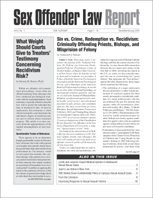Proposed and Enacted Legislative Changes in Sex Offender Management
Author: Jennifer McCarthy.
Source: Volume 07, Number 02, February/March 2006 , pp.17-20(4)

< previous article |next article > |return to table of contents
Abstract:
The amendment of prior sex offenderlaws and the creation of new laws has been the typical legislative response to high profile cases of child abductions and child murders by sex offenders. These laws have either placed stricter registration requirements on sex offenders who live in the community or imposed stricter sentences which serve to incapacitate these offenders for longer periods of time. In the past decade, four of the most prominent examples of the legislative response to the management of sex offenders in the community has been the enactment the following acts: 1. The Wetterling Act (named after Jacob Wetterling, abducted in 1989), passed as part of the 1994 Violent Crime Control and Law Enforcement Act; 2. Megan’s Law (named after Megan Kanka, killed in 1994), enacted in 1996 and amended The Wetterling Act; 3. The Pam Lynchner Sex Offender Tracking and Identification Act of 1996 (named after Pam Lynchner, who was attacked and sexually assaulted) further amended The Wetterling Act; and 4. The Jacob Wetterling Improvements Act (1997) heightened the registration requirements for sex offenders in the community. These laws bear witness to the notion of zero tolerance regarding sex offenses in general.Keywords:
Affiliations:
1: New York Center for Neuropsychology and Forensic Behavioral Science.